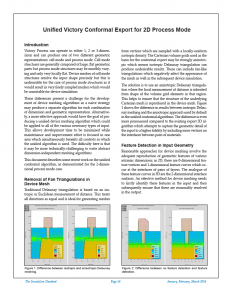Unified Victory Conformal Export for 2D Process Mode
Introduction
Victory Process can operate in either 1, 2 or 3-dimensions and can produce one of two different geometric representations: cell mode and process mode. Cell mode structures are generally composed of large, flat geometric parts but process mode structures may be smoothly varying and only very locally flat. Device meshes of cell mode structures resolve the input shape precisely but this is undesirable for the case of process mode structures as it would result in very finely sampled meshes which would be unsuitable for device simulation.
These differences present a challenge for the development of device meshing algorithms as a naive strategy may produce a separate algorithm for each combination of dimension and geometric representation. Alternatively, a more effective approach would have the goal of producing a unified device meshing algorithm which could be applied to all of the various necessary types of input. This allows development time to be minimised while maintenance and improvement effort is focused in one area which simultaneously benefits all contexts in which the unified algorithm is used. The difficulty here is that it may be more technically-challenging to write abstract dimension-independent meshing algorithms.
This document describes some recent work on the unified conformal algorithm, as demonstrated for the 2-dimensional process mode case.



